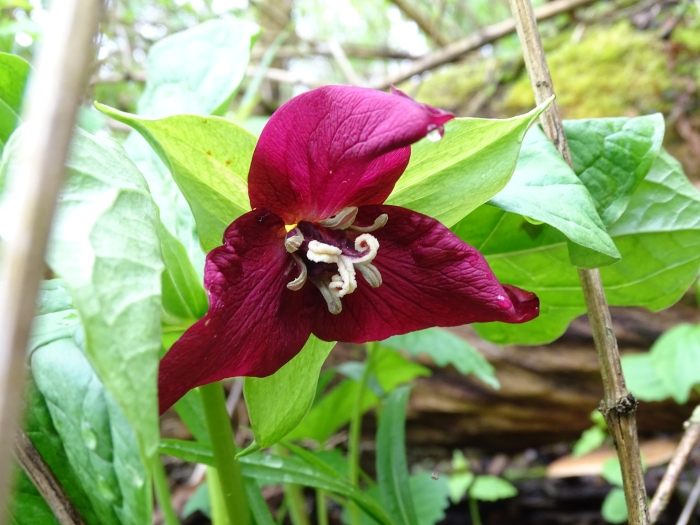Red Trillium
(Trillium erectum)
Red Trillium (Trillium erectum)
/
/

Reuven Martin
Public Domain
Image By:
Reuven Martin
Recorded By:
Copyright:
Public Domain
Copyright Notice:
Photo by: Reuven Martin | License Type: Public Domain | License URL: http://creativecommons.org/publicdomain/zero/1.0/ | Rights Holder: Reuven Martin | Publisher: iNaturalist | Date Created: 2019-05-13T15:01:46-07:00 |

















































Estimated Native Range
Summary
Trillium erectum, commonly known as Red Trillium, is a deciduous perennial herb native to rich, moist, deciduous and mixed forests in the Eastern United States and Canada. It typically grows to a height of 1-2 feet and a width of up to 1 foot. The plant is notable for its three-petaled flowers, which can be various shades of red, maroon, or occasionally white, and bloom in the spring. The flowers are quite showy and emit a faint odor that attracts pollinators. Red Trillium has a whorl of three broad leaves below the flower, which adds to its distinctive appearance.
Red Trillium is valued for its striking flowers and is often used in shade gardens, woodland plantings, and naturalized areas. It is relatively low-maintenance when grown in conditions that mimic its natural habitat. The plant prefers partial to full shade, consistently moist soil with good organic content, and cool, temperate climates. While it can tolerate a range of soil drainage types, it does not do well in dry conditions. Red Trillium can be slow to establish and spread, but once settled, it forms an attractive ground cover. It is important to note that all parts of the plant are toxic if ingested, and it should not be consumed by humans or animals.CC BY-SA 4.0
Red Trillium is valued for its striking flowers and is often used in shade gardens, woodland plantings, and naturalized areas. It is relatively low-maintenance when grown in conditions that mimic its natural habitat. The plant prefers partial to full shade, consistently moist soil with good organic content, and cool, temperate climates. While it can tolerate a range of soil drainage types, it does not do well in dry conditions. Red Trillium can be slow to establish and spread, but once settled, it forms an attractive ground cover. It is important to note that all parts of the plant are toxic if ingested, and it should not be consumed by humans or animals.CC BY-SA 4.0
Plant Description
- Plant Type: Herb
- Height: 1-1.5 feet
- Width: 0.667-1 feet
- Growth Rate: Moderate
- Flower Color: Red, Purple, Green
- Flowering Season: Spring
- Leaf Retention: Deciduous
Growth Requirements
- Sun: Part Shade
- Water: Medium
- Drainage: Slow, Medium, Fast
Common Uses
Bank Stabilization, Bee Garden, Deer Resistant, Low Maintenance
Natural Habitat
Rich, moist, deciduous and mixed forests in the Eastern United States and Canada
Other Names
Common Names: Bethroot, Stinking Benjamin, American Wood Lily, Wakerobin, Purple Trillium, Bethroot, Birthwort, Ill-Scented Trillium, Ill-Scented Wake Robin, Trille Dressé
Scientific Names: , Trillium erectum, Trillium erectum f. erectum,
GBIF Accepted Name: Trillium erectum L.